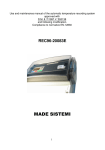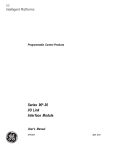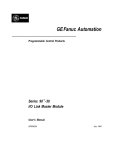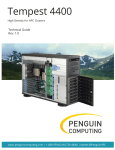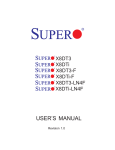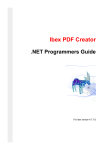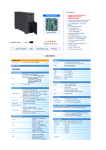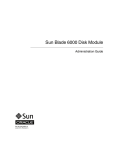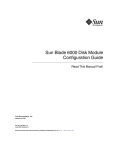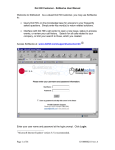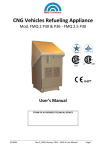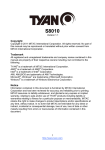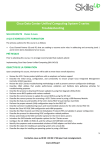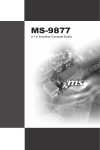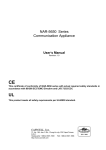Download RC FAQ 3.18.10:Layout 1.qxd
Transcript
R A I D C O R E TM • • • • • • • • • FAQs Q. What is the fundamental difference between software and hardware RAID? A. Hardware RAID offloads the RAID I/O processing and memory utilization (for caching) from the host onto a peripheral device such as hardware RAID adapter. In the case of Software RAID the host processor and memory perform the RAID operations of the controller. In hardware RAID the “smarts” are in the firmware. In software RAID the “smarts” are in the driver stack. Q. What is a Virtual RAID Adapter? A. A Virtual RAID Adapter (VRA) is a unique and new class of pure, host-based software RAID solution that combines the key advantages of pure software RAID with many of the key advantages of hardware RAID adapters. Unlike other host-based offerings, VRA solutions are not tied to any single vendor’s disk IO controller. This makes VRAs universally capable of working on a variety of mainstream SATA or SAS IO devices. The universal nature of VRA technology allows OEMs to easily migrate to new hardware platforms while maintaining their same look and feel and without having to change RAID vendors. Q. What are the key advantages of RAIDCore? A. RAIDCore, as a Virtual RAID adapter, blend the advantages of pure software RAID with many of the advantages of hardware RAID adapters. • Lower total cost of ownership (TCO) o Lower Acquisition Costs – Eliminate the extra cost of the hardware RAID adapter o Lower Operating Costs – Eliminate the associated power and cooling costs o Lower Maintenance Costs – No battery to replace or dispose of o Lower Support Costs – Commonality of RAID stack (i.e., one common stack versus multiple RAID stacks) reduces training and supports costs • Cost effective in that software RAID utilizes the host resources and IO components of the motherboard. This maximizes the investment of the motherboard and makes good use of idle resources o Uses CPU cycles, internal bus, main memory and onboard IO ports o A CPU and memory upgrade can be less expensive and more effective then a hardware controller • Scaled performance – Overall RAID effectiveness increases as host CPU count (multi-thread, multi-core) and system memory increases, following current market trends. • Server slot management – PCI slots can be used for other function (e.g., SAS tape adapter, FC HBA) • Boot protection – The boot image can be RAID protected prior to loading the operating system mitigating corruption should a disk failure occur during the boot process. • Advanced Functions – Hardware RAID adapters typically serve as a platform for advanced functions such as online RAID level migration (RLM), on-line capacity expansion (OCE) and SAS expansion. • Scalability – With SAS expansion support, the number of drives supported is much greater than with software RAID, approaching the capabilities of hardware RAID adapters. • • • • • • • • • • • • • • • • • • • • • • • • • • • • • • • • • • • • • • • • • • • • • • • • • • • • • • • • • • FAQs RAIDCore – Virtual RAID Adapter – FAQ RAIDCore FAQs Q What are the RAID options for the varying kinds of storage configurations? A Internal and internal + JBOB storage configurations typically leverage host-based software or hardware adapters for RAID protection. External JOB storage configurations typically leverage host-based hardware adapters for RAID protection while external RAID disk arrays have dedicated controllers with embedded RAID firmware. In particular it is with internal storage and internal + JBOD expansion storage configurations where software versus hardware RAID comparison is relevant. Even here there are different implementations of RAID. Software RAID can either run entirely on the host with no additional hardware, or it can be hardware-assisted. Hardware-assisted RAID leverages a plug-in host bus adapter (HBA) with a RAID BIOS or an additional RAID BIOS integrated with the motherboard. Q What storage configuration is RAIDCore best suited for? A RAIDCore is targeted at internal and internal + JBOD expansion storage configurations. Q How is RAIDCore positioned? A RAIDCore is targeted as a low cost, entry level, RAID offering and positioned for SMB servers and workstations. Q What is the target market for RAIDCore? A The target market for RAIDCore is entry-level servers and workstations • Entry level RAID 0/1/5/10 class servers at OEMs are coming under attack from lower priced competitors. These servers can not feasibly deploy the more expensive Hardware RAID adapters as some HBA’s cost more than the system they’re meant to go in. • Most hardware components have scaled down in cost, except the RAID card which is still very costly depending on implementation. • RAIDCore supports the removal of all hardware costs for RAID at the lowest end and replacement of a fully hardware class RAID stack without compromising features. Q What is the current release level of RAIDCore A The current release level is 5.1.3. Q What Southbridge chip sets does RAIDCore support? A RAIDCore supports the following Southbridge chip sets: AMD – SB700, SP5100, Intel – ICH9R, ICH10R, Ibex Peak Q What SAS IOC chip sets does RAIDCore support? A RAIDCore supports the following SAS IOC chip sets: (Note: all on motherboard; not on an HBA): LSI – 1064E, 1068E, Marvell – 6440 Q What operating systems does RAIDCore 5.1.3 support? What operating systems are not supported? A Supported: Windows Vista 32/64 bit Windows 7 64 bit Windows Server 2003 32/64 bit Windows 2008 Server 32/64 bit Windows 2008 R2 Server 64 bit Red Hat® Enterprise Linux 5.3 32/64 bit Red Hat® Enterprise Linux 5.4 32/64 bit SuSE® Linux Enterprise Server 10.3 32/64 bit SuSE® Linux Enterprise Server 11 32/64 bit Linux SDK Available RAIDCore FAQs Q A What functions are supported? What functions are not supported? Supported: RAID 0, 1, 5, 10, non-RAID disks Up to 8 Virtual Disks Virtual Disk Slicing Support for SATA & SAS HDDs (depends on IO controller) Support for SATA SSDs Global & Dedicated Hot Spare Support Consistency Check SATA Native Command Queuing (drive dependent) eSATA device support Background Initialization Rebuild Check-pointing Selectable Boot Order CDU/SBUU Integration Online Capacity Expansion (OCE) SATA Tape Support SATA Optical Disk Support Internal Storage Only O-ROM Management Utility (CTRL+R) (on select motherboards with BIOS Online Raid Level Migration (RLM) Controller Spanning Not Supported: RAID 6, 50, 60 > 8 Virtual Disks Support for 6GB SAS HDDs DDF Support Battery Support Expander Support External Enclosure Support Workstation (Client) Support uEFI Support integration only) Q What is Array Migration? A Migration refers to the migration of an array from one controller to another. (Note: RAID Level Migration (RLM) is not supported). Migration of complete arrays in good or optimal state is supported. Not all migrations are supported by all operating systems. • Migration of non-optimal arrays is not supported and migration of partial arrays is not supported. Q What is Drive Roaming? A Roaming refers to the movement of a HDD from one slot to another on the same controller. Roaming of physical devices on the same controller is supported and will not affect the recognition or status of arrays created on those members. Q What is Foreign Configuration Import? A Foreign volumes are imported automatically. No user intervention is required. This happens during the boot process and no action is required by the user in CTRL-R (on select motherboards with the BIOS integrated Option ROM) • • • • Foreign configurations should be imported while the system is turned off. Only Optimal foreign arrays can be imported. The import of degraded arrays is not supported. Partial foreign import is not supported. Hot Plug of Foreign volumes is not supported. Q Is there serial debug output? A No, there is no serial debug output. Q Is SAS firmware update supported? A SAS F/W update is available in Windows only and requires that the driver be installed. Q Are optical disk drives supported? A Up to two optical disk drives (ODDs) can be supported on a system. Only a single ODD is supported as a boot device. Q Is boot from tape supported? A “Boot from Tape” is not supported. RAIDCore FAQs Q What is the BIOS Configuration Utility (CU)? A On select motherboards with the BIOS integrated Option ROM, the BIOS Configuration Utility (CU) is a user application provided to perform configuration tasks through the BIOS. Among the functionality provided by the CU: • RAID configuration (creation only) • Miscellaneous controller properties and options • Some diagnostic & status information about the controller and attached HDDs. The CU is invoked by pressing <CTL> R when prompted during system POST. Q What is the Option ROM (BIOS)? A (Note: The terms “Option ROM” and “BIOS” are often used interchangeably.) The Option ROM (O-ROM) provides initial access to HDDs and virtual disks to allow the system to access and configure drives and/or the controller prior to the loading of an operating system. The O-ROM is loaded automatically by the platform’s system BIOS; it is included in the platform BIOS image. Q What methods are available to manage my arrays? A On select motherboards with the BIOS integrated Option ROM, CTRL-R provides a subset of RAIDCore features in a PreO/S environment. There is a GUI included. There is also a CLI (command line interface) available under select command processors. Q How does RAIDCore ensure RAID 1 mirror and RAID 5 parity consistency in the event of power loss (i.e., like using batterybacked cache in disk arrays)? A RAIDCore has a feature called Touched Region Logging (TRL) to ensure RAID 1 mirror and RAID 5 parity consistency in the event of power loss or system failure for in-progress writes.TRL employs a bitmap journal of write operations to protect against the damage of a power outage or critical failure during a write operation. In layman’s terms, it is akin to a journal in an RDBMS application, but at much deeper level (bits vs. transaction). Q When will RAIDCore support RAID 6? Will it conform to the standard developed by Dell, Intel and LSI in terms of encoding? A RAID 6 support is a future enhancement but there is no committed schedule at this time. Q Does this software work with Nehalem-based motherboards? A Yes, but no native instructions – all vanilla SSE/MMX. RAIDCore supports ICH7R, 8R, 9R, 10R and PCH as well as AMD’s SB700, SP5100. Q Does this software work in supporting systems with as many as 24 disk drives, with associated SAS/SATA dumb JBOD controllers? A RAIDCore supports up to 32 disks without SAS expansion (e.g. spanned across four (4) 8-port SATA or SAS controllers such as an LSI 1068). There is no support for JBOD/SAS expansion yet; this is planned for 2010 with up to 64/128 drive support. Q Which SATA/SAS PCIe2.0 cards do you support? A The focus today has been on motherboard only SATA ports and LSI 1068E/2008E chipsets mounted directly on the motherboard. DHS doesn’t manufacture any HBAs, but RAIDCore has supported SAS IOCs on HBAs with Marvell 64xx, Broadcom BCM8603, and LSI 1068e chips. We’re already working on the LSI2008e with another partner. Q How are drive activity and failure LED’s supported? A Older generations of RAIDCore use a GPIO method in hardware. In the UI there are some feature rich LED functions (identify, LED/chassis JPEG image overlay for visual ID, etc, etc). See the user manual for more details. DHS will be adding SGPIO support to a future release to manage embedded systems that want to drive mid-planes off the motherboard SGPIO capability (e.g. as in Supermicro’s motherboards) RAIDCore Q What documentation is available for review? A RAIDCore comes with a User’s and a Quick Start Guide. FAQs www.dothill.com © 2009, Dot Hill Systems Corp., All rights reserved. Dot Hill and the Dot Hill logo trademarks of Dot Hill Systems Corp. RAIDCore is a trademark of Broadcom Corporation and/or its affiliates in the United States and certain other countries.This document is for informational purposes only, and does not set forth any warranty, expressed or implied, concerning any product or service offered or to be offered by Dot Hill. Dot Hill reserves the right to make changes to this document at any time, without notice, and assumes no responsibility for its use. No part of this document may be copied or reproduced without written permission of Dot Hill Systems Corp.3.18.10




